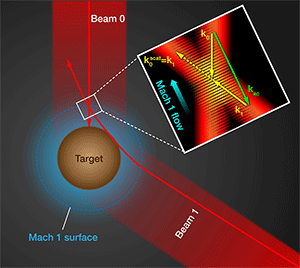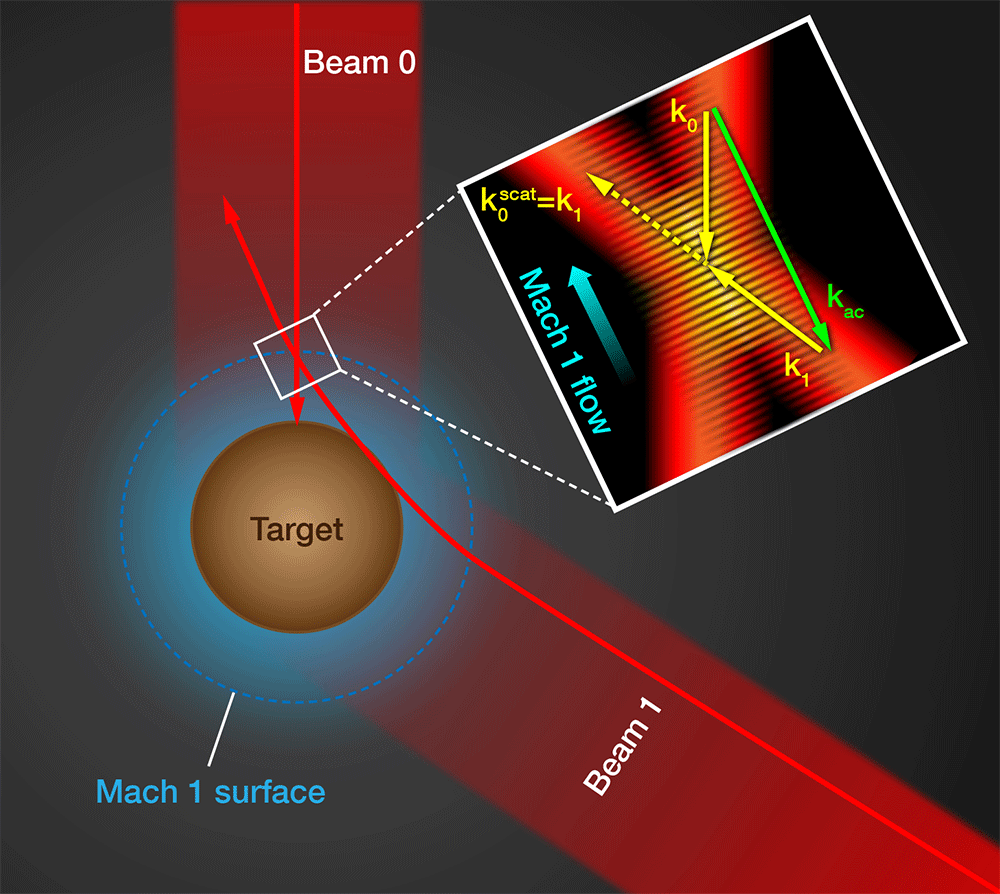Zooming in on Laser-Driven Fusion
For several decades, researchers have been using the world’s most powerful lasers to try to recreate the fusion reaction that occurs in stars. The process, called inertial confinement fusion (ICF), uses multiple laser beams to compress and heat a small, spherical target containing nuclear fuel, in order to ignite thermonuclear fusion. In principle, the heat released from the reaction could provide an alternative energy source, but the challenges to achieving ignition are many. One, in particular, is to understand and control a process first identified in the mid-1990s [1] called crossed-beam energy transfer (CBET), in which the laser beams exchange energy with each other as they overlap in the plasma. In laser-driven fusion experiments, CBET occurs just before the laser beams deposit their energy into the target. The effect can therefore modify the finely tuned symmetry of the beams [2,3] or cause energy to leak out of the target [4,5].
Now, Igor Igumenshchev from the Laboratory for Laser Energetics at the University of Rochester in New York and colleagues are proposing a new technique to mitigate the negative effects of CBET. In Physical Review Letters, Igumenshchev et al. use simulations to show that dynamically reducing—or “zooming”—the spot size of the lasers as they interact with the target would reduce energy transfer between the beams, without disrupting the symmetry of the laser illumination [6]—a negative side effect of some existing proposals for correcting CBET.
The CBET process is relatively simple to explain. When two laser beams overlap in a plasma (Fig. 1), they create a beat wave. Free charges in the plasma accumulate where the beat wave’s electric field is weakest (a result of what is known as the ponderomotive force) and this accumulation of charges modulates the refractive index, in effect creating a Bragg diffraction grating for the lasers. Because this grating is created by the beat wave, the Bragg condition is, by construction, always satisfied. Moreover, if there is a wavelength separation between the laser beams, or the plasma flows, the grating can move at (or close to) the speed of sound. The moving grating will then scatter light from one beam in the exact direction of the other beam, effectively transferring energy from one laser beam to the other.
CBET manifests itself in different ways depending on the geometry of the inertial confinement experiment. In an “indirect-drive” experiment, which is the current focus of the National Ignition Facility (NIF) at Lawrence Livermore National Laboratory in California, multiple laser beams are focused on a spherical target (a mixture of deuterium and tritium) that is placed inside a cylindrical gold cavity called a “hohlraum.” The laser-heated cavity generates x rays that, in turn, heat the outer shell of the target, causing it to expand rapidly. To conserve momentum, the target implodes, compressing the fuel and igniting thermonuclear burn. In this configuration, CBET occurs at the entrance holes of the hohlraum where all the beams overlap. The setup at NIF was specifically designed to allow researchers to control the phase velocity of the Bragg grating and thus adjust the amount of CBET. Since the first experiments in 2009, this capability has been used to direct the energy deposition inside the hohlraum and tune the implosion symmetry of the nuclear fuel target [3,7].
Soon after these early experiments, researchers at the Laboratory for Laser Energetics calculated that CBET could also occur in a “direct-drive” experiment but with a different configuration and different consequences [4]. In the direct-drive geometry, the laser beams directly irradiate the spherical target. As illustrated in Fig. 1, rays from an incoming beam (“beam ”) can intersect rays from a second beam (“beam ”) that refract off the edges of the target. If the intersection occurs where the surface is expanding at the speed of sound (the “Mach 1” surface), the grating created by the beat wave will also travel at this speed, scattering light from beam towards beam . Because of this geometry, CBET preferentially leads to a transfer of energy from the central portion of each laser beam—the part that most efficiently couples its energy to the target—to the outer portions of the other beams, which then refract off the target without depositing all their energy.
In previous work, Igumenshchev et al. used the University of Rochester OMEGA laser to study CBET in a direct-drive configuration, estimating that the process could drain – of the laser energy from the target [4]. They also showed that using smaller laser spot sizes reduces the effects of CBET, since it allows less light to refract off the edges of the target. But there is a catch: smaller laser spots produce a less uniform illumination pattern on the surface of the spherical target. This, in turn, leads to a less uniform compression of the target, one of the most critical ICF requirements. Experiments indicate that a good compromise between these two effects is to use a beam with a diameter near 80% of the initial target diameter [5].
What the Rochester group is proposing now [6] may prove to be an even more effective way of controlling CBET than simply reducing the laser spot size. Igumenshchev et al.’s key insight is that the negative effects of CBET and radiation asymmetry occur at different times during the target’s implosion. The symmetry of the laser illumination is crucial in the first few nanoseconds after the lasers interact with the target, when nonuniformities can drive low-frequency perturbations on the surface of the spherical target, which grow as it implodes and reduce the implosion performance. At later times, though, the plasma corona has sufficiently expanded to smooth out radiation nonuniformities. But it also offers a favorable terrain for CBET to occur. Igumenshchev et al.’s proposal is to drive the first few nanoseconds of the laser pulse with large spots that are roughly the same diameter as the size of the target; then, at later times, switch to spot sizes that are – smaller, in order to reduce CBET and maintain good energy coupling to the target. The authors show, using 2D hydrodynamics simulations, that tailoring the spot size in this way yields an implosion performance that is almost as good as the ideal case: a purely spherically symmetric implosion.
How would this tuning of the spot size be achieved in practice? The authors imagine a new type of optical element called a “zooming phase plate,” which would produce a different spot size depending on whether a laser lands on the central part of the plate or the outer edges. With such a plate, it would be possible to send two consecutive laser pulses toward the plasma: a first pulse that hits only the outer area of the plate and produces a large spot on the target, and a second pulse that covers the center of the plate and produces a – smaller spot on the target.
One concern about this work is that Igumenshchev et al.’s 2D simulations do not actually model CBET, since they assume beam zooming makes the effect negligible. This is probably true, at least qualitatively. But future quantitative assessments of beam zooming for direct-drive experiments will require a proper CBET model, and this might not be an easy task. Ray-based models such as those used for direct-drive make it difficult to define the distribution of the laser intensity, especially when rays from the same beam refract at various—and large—angles. A self-consistent treatment of CBET and hydrodynamics is also desirable since the two can mutually affect each other [8]. Another point worth considering is that the laser intensity during the last part of the laser pulse, when the power reaches its maximum, will also be higher if smaller spots are being used. This could trigger other unexpected laser-plasma instabilities, which may deteriorate the implosion performance.
According to the authors, beam zooming might not be applicable to the upcoming full-scale experiment at NIF, which uses a “polar-drive” configuration instead of the configuration the authors simulate. But Igumenshchev et al.’s ideas may influence future versions of the experiment at NIF and at other large-scale laser facilities around the world. The researchers at the Laboratory for Laser Energetics are taking the issue seriously and making quick progress towards harnessing the CBET phenomenon and improving our understanding of it. Discoveries along these lines could lead to improved designs of inertial confinement fusion and new ways of controlling and exploiting the interaction between lasers and plasma.
References
- W. L. Kruer, S. C. Wilks, B. B. Afeyan and R. K. Kirkwood, “Energy Transfer Between Crossing Laser Beams,” Phys. Plasmas 3, 1 (1996)
- J. D. Moody et al., “Multistep Redirection By Cross-Beam Power Transfer Of Ultrahigh-Power Lasers In A Plasma,” Nature Phys. 8, 344 (2012)
- P. Michel et al., “Tuning the Implosion Symmetry of ICF Targets via Controlled Crossed-Beam Energy Transfer,” Phys. Rev. Lett. 102, 025004 (2009)
- I. V. Igumenshchev et al., “Crossed-Beam Energy Transfer in Implosion Experiments on OMEGA,” Phys. Plasmas 17, 122708 (2010)
- D. Froula et al., “Increasing Hydrodynamic Efficiency by Reducing Cross-Beam Energy Transfer in Direct-Drive-Implosion Experiments,” Phys. Rev. Lett. 108, 125003 (2012)
- I. V. Igumenshchev et al., “Laser-Beam Zooming to Mitigate Crossed-Beam Energy Losses in Direct-Drive Implosions,” Phys. Rev. Lett. 110, 145001 (2013)
- S. Glenzer et al., “Symmetric Inertial Confinement Fusion Implosions at Ultra-High Laser Energies,” Science 327, 1228 (2010)
- P. Michel, W. Rozmus, E. A. Williams, L. Divol, R. L. Berger, R. P. J. Town, S. H. Glenzer, and D. A. Callahan, “Stochastic Ion Heating from Many Overlapping Laser Beams in Fusion Plasmas,” Phys. Rev. Lett. 109, 195004 (2012)





